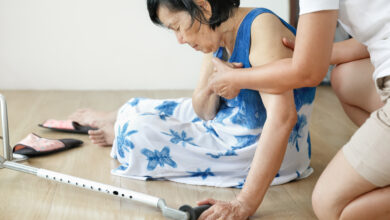Scrubbing OUT infection carriers
Experts worry that misuse of scrubs might be spreading infections in hospitals. By Aileen Macalintal
Ideally, scrubs should be changed every day, after every operation and whenever medical staff leave operating theatres - but this has not been the case.
"If scrubs are used in theatre, then they should not be worn in general ward areas," said infectious diseases expert Professor Peter Collignon. "The only way you can police that is when they are a different colour to ones worn in, say, the emergency department, where they are now the 'uniform'."
Collignon, Canberra Hospital's director of infectious diseases unit and microbiology department, is an advocate of colour-coding scrubs to each department. He has written about the increasing trend of wearing surgical scrubs as "street clothes", worn outside restricted areas such as operating rooms and even in non-clinical areas such as the cafeteria and the library.
"To allow [this practice] to continue will foster the perception, both in institutions and communities, that important infection-control practices are being breached and no corrective action is being taken," he said.
"Once the surgical scrubs have been worn outside the restricted area, they may be contaminated with bacteria from patients in the wards," wrote Collignon and his team.
Uniform contamination
A number studies have shown how healthcare workers' uniforms are a potential agent of infection spread.
"The attire of healthcare professionals carries organisms, which can be transferred from the environment to patients or from one patient to another," said Professor Ramon Shaban of Griffith University, an infection-control expert.
Denver Health Medical Centre in the US found that the level of bacterial contamination in doctors' newly cleaned uniforms after an eight-hour workday was similar to that in infrequently washed white coats. This means bacteria are found in doctors' scrubs and gowns no matter how often they are laundered, according to the 2011 US study published in the Journal of Hospital Medicine.
"Bacterial contamination occurs within hours of donning newly laundered short-sleeved uniforms," the report concluded.
Another study focused on nurses' frequent wiping of hands on their uniforms and how infrequently they washed their hospital clothes, and how these linked to hospital-acquired infections (HAIs).
Cindy Halliwell and Robyn Nayda's 2011 report, Nurses' uniforms: The missing link in breaking the chain of hospital-acquired infection?, published in Healthcare Infection, estimated that 6.3 per cent of hospitalised people acquire HAIs. The study also estimated the annual cost of HAI in Australia at $686 million, with over 150,000 Australians affected by HAIs every year.
To reduce the risk of HAI, contaminated uniforms should be given considerable attention by managers, educators and clinicians, the report recommended.
Hospital policies
When and where scrubs should be worn depends on the hospital, said a spokesperson for the Australian Nursing Federation (ANF). Generally, nurses and midwives wear scrubs in healthcare settings including operating theatres, day surgery suites, emergency departments, delivery suites and - in some hospitals - intensive care units, said the spokesperson, who emphasised that "it is mandatory to wear scrubs in operating theatres".
Most hospitals implement their own policies - for instance, on wearing an over gown to protect the scrubs whenever a nurse or midwife moves out of patient-care areas and operating theatres.
"Clearly, it would not be best practice for nurses and midwives to wear scrubs in cafeterias and other non-patient care areas, or to and from the place of employment," the spokesperson said.
Under international guidelines, all healthcare workers should wear protective clothing such as apron and gown when in close contact with a patient, when materials or equipment may contaminate skin, or when there is blood, body substances, secretions or excretions - except sweat - in uniforms or other clothing. Also, gowns and aprons must be changed between patients.
To ensure zero infection, Professor Shaban said hospitals should refer to the Australian Guidelines for the Prevention and Control of Infection in Healthcare (2010).
These guidelines include competency standards in surgical scrubbing, gowning and gloving. One guideline, for instance, says: "Aprons or gowns should be appropriate to the task being undertaken. They should be worn for a single procedure or episode of patient care and removed in the area where the episode of care takes place."
Shaban also said hospitals may be guided by the Australian College of Operating Room Nurses publication The ACORN Standards for Perioperative Nursing. One hospital that aligns its operating procedures with the ACORN standards is the Royal Hospital for Women in Sydney: "All shirts, pants, skirts and dresses are to be removed. Short-sleeved undergarments are permitted to be worn providing they are not visible under the short-sleeved scrub tops issued."
Fresh daily
Asked how often scrubs should be changed and laundered, Halliwell said further research was needed to establish a rule, but "a minimum of daily would be a good starting point".
Infection experts would like a dress-code policy for restricted and semi-restricted areas in the hospital. Collignon and fellow researchers have said that scrubs need to be changed daily and as necessary, such as in the event of bloodstain. The ACORN standards agree: "A clean set of hospital-supplied perioperative attire must be worn each day and changed when visibly soiled.
"Scrubs are a form of personal protective equipment (PPE)," said Shaban. "These are barriers that - when used alone or in combination with aprons, gowns, gloves and surgical masks - protect mucous membranes, airways, skin and clothing from contact with infectious agents."
But if scrubs become spreaders of infection themselves, doctors and healthcare professionals need stricter controls on their use. Colour-coded scrubs would seem to be a good first step.
Email: [email protected]





